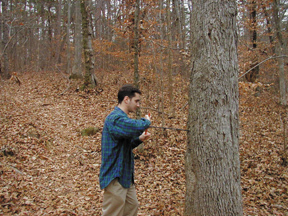 Drilling wells
to monitor uranium contamination is a big, expensive job. Two geologists at
the University of North Carolina at Chapel Hill may have found an alternative
solution. A study by Drew Coleman and his graduate student Michael Bulleri suggests
geologists can measure radiation much more cheaply by analyzing tree cores.
Drilling wells
to monitor uranium contamination is a big, expensive job. Two geologists at
the University of North Carolina at Chapel Hill may have found an alternative
solution. A study by Drew Coleman and his graduate student Michael Bulleri suggests
geologists can measure radiation much more cheaply by analyzing tree cores.
[At right, Mike Bulleri cores an oak tree in North Carolina. Courtesy of Drew Coleman.]
Uranium occurs naturally in soil and groundwater, as well as in a depleted form from contamination. Trees take up water from the ground and store radioactive elements for many years. By comparing isotopic ratios within the tree cores, Coleman and Bulleri could distinguish between natural and depleted uranium species. They presented their work at the annual Geological Society of America meeting in November.
Bulleri cored oak trees located on public and private lands surrounding a depleted uranium weapons manufacturing site outside Concord, Mass. He and Coleman measured uranium concentrations in the living parts of the oaks, called sapwood, using a thermal ionization mass spectrometer and a technique known as isotope dilution.
Coleman says the data they collected show that trees store uranium in both their bark and their wood. “We’ve been able to demonstrate with both uranium and lead that the oaks are sampling two distinct contaminant sources that we assume are near surface water, in the wood; and airborne particles, in the bark.”
The average uranium concentration in the sapwood of one tree matched that found in an adjacent well over the same interval. Also, Coleman says, uranium levels rose rapidly in the tested sapwood located next to contaminated groundwater plumes and dropped to zero a short distance away, except in areas of high airborne transport and in an area with anomalously high concentrations of depleted uranium in air. Coleman says this anomalous area is critical in showing the value of the core testing, because it revealed an area of contamination in groundwater that was otherwise unexpected. “Because trees provide such a rapid, inexpensive tool for tracking the contaminant, it would be easy to identify other such ‘unexpected’ concentrations,” he says.
He emphasizes, though, that their work is relatively new, and they have many unanswered questions. Future plans for the research include investigating if tree species other than oak are better for monitoring uranium, learning where the uranium is stored and how it moves, and testing their method at more contaminated sites.
Still, with each tree analysis costing under $100, Coleman says, the team has high hopes for using tree coring as an alternative to well drilling to monitor nuclear and radioactive sites across the United States. “The fact that we can sample so quickly over so broad an area and that there is no experiment to set up to accomplish this is exciting to me,” Coleman says. “The trees have been collecting our samples for decades. All we need to do is extract the data from them.”
Lisa M. Pinsker

